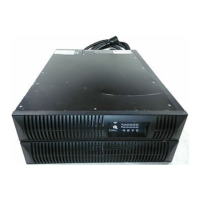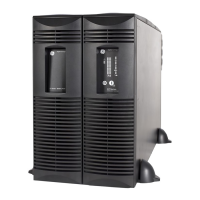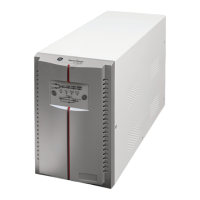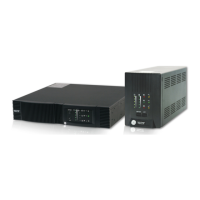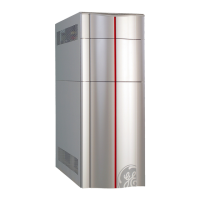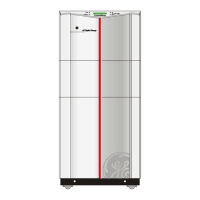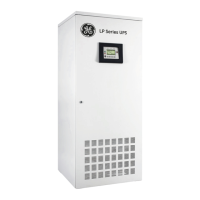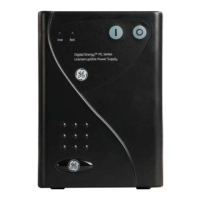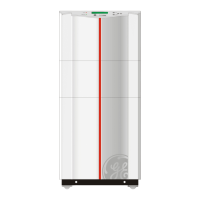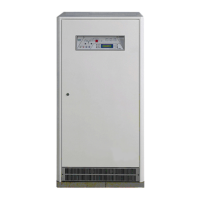Do you have a question about the GE GT10000 and is the answer not in the manual?
Manual contains important instructions for UPS installation and maintenance. Keep for future references.
General safety warnings and precautions related to electrical hazards, servicing, and product classification.
Overview of the GE Digital Energy GT Series UPS and its purpose.
Specifies the designed purpose of UPS for protecting sensitive electronic equipment from power interference.
Guidelines for safe transportation and storage of the UPS unit.
Details the warranty coverage for GE Consumer & Industrial SA products.
Lists the items included in the UPS and battery cabinet shipping boxes.
Important rules and conditions to follow before and during UPS installation.
Step-by-step guide for installing the UPS, covering various methods.
Preparations required for installing the UPS in a 19-inch rack.
Preparations required for installing the UPS in a vertical tower format.
Instructions on how to connect the battery pack to the UPS unit.
Guide for connecting communication devices like DB9 port and SNMP slot.
Identification and explanation of components located on the rear panel of the UPS.
Detailed steps for the standard UPS installation process.
Information on connecting multiple UPS units to operate in a parallel system.
Steps and considerations for installing a parallel UPS system.
Detailed instructions for making the parallel cable connections between UPS units.
Description of the UPS front panel controls, LEDs, and load indicators.
Step-by-step instructions for starting up a single UPS unit or a parallel system.
Conditions and procedures for normal UPS operation.
Details the conditions required for the UPS to operate normally.
Instructions on how to properly switch off the UPS unit.
Explains the meaning of various status and alarm indicators on the UPS.
Describes the UPS operation when it is in bypass mode.
Explains UPS operation when running on battery power.
Indicates the alarm condition when UPS battery runtime is low.
Describes the condition when bypass is inhibited due to input voltage/frequency limits.
Explains the overload condition and how the UPS reacts.
Information and instructions regarding battery replacement.
Details the priority and buzzer behavior for different alarms.
Describes the UPS behavior and indicators in fault mode.
Explanation of the UPS stand-by mode and how to enter it.
Information on connecting an external emergency shutdown device.
Instructions for setting up and using the Remote Power Off function.
Explains the no-load shutdown function and its default setting.
Details the Auto Restart function and how to enable/disable it.
Overview of features for maximum battery life and reliability.
Information on the RS232 DB9 port for UPS communication.
Details on connecting to an Ethernet network via an SNMP card.
Critical safety warnings regarding high voltages within the UPS.
General maintenance guidelines and recommendations for the UPS.
Instructions and information on environmentally responsible disposal of the UPS.
Information about battery service life and replacement alarms.
Step-by-step guide for replacing the UPS batteries.
Manual contains important instructions for UPS installation and maintenance. Keep for future references.
General safety warnings and precautions related to electrical hazards, servicing, and product classification.
Overview of the GE Digital Energy GT Series UPS and its purpose.
Specifies the designed purpose of UPS for protecting sensitive electronic equipment from power interference.
Guidelines for safe transportation and storage of the UPS unit.
Details the warranty coverage for GE Consumer & Industrial SA products.
Lists the items included in the UPS and battery cabinet shipping boxes.
Important rules and conditions to follow before and during UPS installation.
Step-by-step guide for installing the UPS, covering various methods.
Preparations required for installing the UPS in a 19-inch rack.
Preparations required for installing the UPS in a vertical tower format.
Instructions on how to connect the battery pack to the UPS unit.
Guide for connecting communication devices like DB9 port and SNMP slot.
Identification and explanation of components located on the rear panel of the UPS.
Detailed steps for the standard UPS installation process.
Information on connecting multiple UPS units to operate in a parallel system.
Steps and considerations for installing a parallel UPS system.
Detailed instructions for making the parallel cable connections between UPS units.
Description of the UPS front panel controls, LEDs, and load indicators.
Step-by-step instructions for starting up a single UPS unit or a parallel system.
Conditions and procedures for normal UPS operation.
Details the conditions required for the UPS to operate normally.
Instructions on how to properly switch off the UPS unit.
Explains the meaning of various status and alarm indicators on the UPS.
Describes the UPS operation when it is in bypass mode.
Explains UPS operation when running on battery power.
Indicates the alarm condition when UPS battery runtime is low.
Describes the condition when bypass is inhibited due to input voltage/frequency limits.
Explains the overload condition and how the UPS reacts.
Information and instructions regarding battery replacement.
Details the priority and buzzer behavior for different alarms.
Describes the UPS behavior and indicators in fault mode.
Explanation of the UPS stand-by mode and how to enter it.
Information on connecting an external emergency shutdown device.
Instructions for setting up and using the Remote Power Off function.
Explains the no-load shutdown function and its default setting.
Details the Auto Restart function and how to enable/disable it.
Overview of features for maximum battery life and reliability.
Information on the RS232 DB9 port for UPS communication.
Details on connecting to an Ethernet network via an SNMP card.
Critical safety warnings regarding high voltages within the UPS.
General maintenance guidelines and recommendations for the UPS.
Instructions and information on environmentally responsible disposal of the UPS.
Information about battery service life and replacement alarms.
Step-by-step guide for replacing the UPS batteries.
| Category | UPS |
|---|---|
| VA Rating | 10000 VA |
| Wattage | 9000 W |
| Topology | Double Conversion Online |
| Input Voltage | 208/240 VAC |
| Output Voltage | 208/240 VAC |
